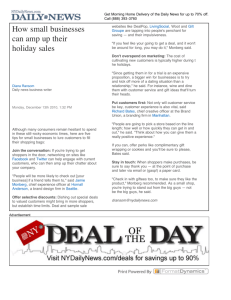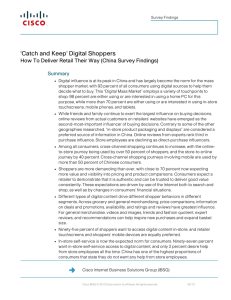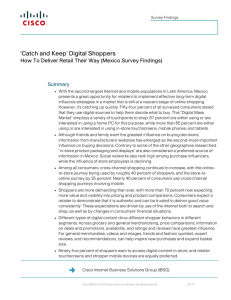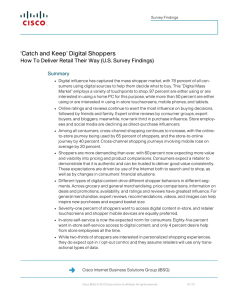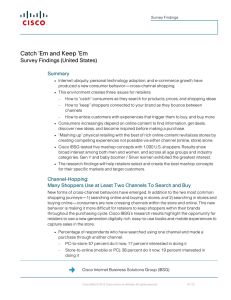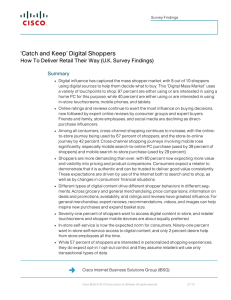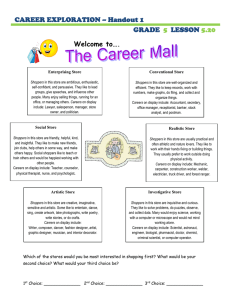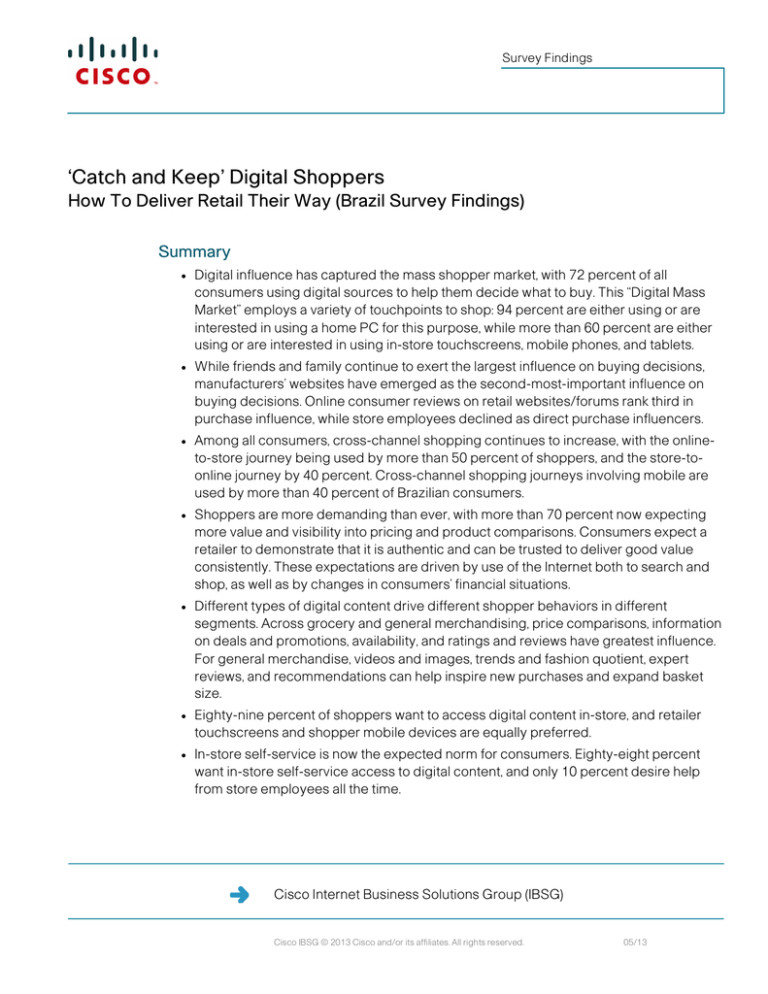
Survey Findings
‘Catch and Keep’ Digital Shoppers
How To Deliver Retail Their Way (Brazil Survey Findings)
Summary
●
●
●
●
●
●
●
Digital influence has captured the mass shopper market, with 72 percent of all
consumers using digital sources to help them decide what to buy. This “Digital Mass
Market” employs a variety of touchpoints to shop: 94 percent are either using or are
interested in using a home PC for this purpose, while more than 60 percent are either
using or are interested in using in-store touchscreens, mobile phones, and tablets.
While friends and family continue to exert the largest influence on buying decisions,
manufacturers’ websites have emerged as the second-most-important influence on
buying decisions. Online consumer reviews on retail websites/forums rank third in
purchase influence, while store employees declined as direct purchase influencers.
Among all consumers, cross-channel shopping continues to increase, with the onlineto-store journey being used by more than 50 percent of shoppers, and the store-toonline journey by 40 percent. Cross-channel shopping journeys involving mobile are
used by more than 40 percent of Brazilian consumers.
Shoppers are more demanding than ever, with more than 70 percent now expecting
more value and visibility into pricing and product comparisons. Consumers expect a
retailer to demonstrate that it is authentic and can be trusted to deliver good value
consistently. These expectations are driven by use of the Internet both to search and
shop, as well as by changes in consumers’ financial situations.
Different types of digital content drive different shopper behaviors in different
segments. Across grocery and general merchandising, price comparisons, information
on deals and promotions, availability, and ratings and reviews have greatest influence.
For general merchandise, videos and images, trends and fashion quotient, expert
reviews, and recommendations can help inspire new purchases and expand basket
size.
Eighty-nine percent of shoppers want to access digital content in-store, and retailer
touchscreens and shopper mobile devices are equally preferred.
In-store self-service is now the expected norm for consumers. Eighty-eight percent
want in-store self-service access to digital content, and only 10 percent desire help
from store employees all the time.
Cisco Internet Business Solutions Group (IBSG)
Cisco IBSG © 2013 Cisco and/or its affiliates. All rights reserved.
05/13
Survey Findings
●
●
Close to 90 percent of shoppers are interested in personalized shopping experiences.
They expect opt-in / opt-out control, and assume retailers will use only transactional
types of data.
As identified in Cisco IBSG’s previous research, “mashing-up” physical retailing with
the best of rich online content revitalizes stores by creating compelling experiences
not possible via either channel (online, store) alone. Once again, we found that
“Mashop” experiences are in high demand by today’s digital shoppers.
Introducing Today’s Digital Shopper Segments
●
●
●
The Digital Mass Market now encompasses nearly 7 out of every 10 shoppers. On
average, close to 70 percent of them either use or are interested in using a mobile
phone, tablet, or touchscreen to shop; 94 percent regularly use or are interested in
using a PC for this purpose. They cross-channel shop mainly via online-to-store and
store-to-online. This segment comprises Gen Y and Gen X, with an almost equal mix of
males and females.
About 1 in 10 shoppers qualifies as Über Digital. These shoppers are connected 24/7,
and more than 90 percent use a smartphone or tablet to shop. They’re the “showrooming,” deal-seeking addicts. Über Digital shoppers are predominantly Generation
Y, with a 55:45 male-to-female ratio. This subsegment is very interested in personalized digital experiences, and is willing to share more personal data. This is the core
segment to watch for future mass-market shopping behaviors. We estimate that the
Über Digital subsegment currently leads the mainstream by 18 to 24 months.
Two in 10 shoppers fall into the “Living in Analog Times” segment. Predominantly baby
boomers and silvers, they rely on stores, newspapers, and television to make their
purchasing decisions. Their technology usage applies mainly to simple cell phones for
voice and text, along with TVs and an occasional PC.
Digital Content Has Significant Influence
●
●
Although friends and family were cited as the most influential source of information to
help shoppers make buying decisions, online sources are quickly catching up. Store
employees ranked consistently low as purchase influencers across geographies, as
shown in the following rankings based on the survey:
–
Friends and family: 52 percent
–
Information from manufacturer’s website: 48 percent
–
Online reviews from retailer websites: 38 percent
–
Advice through social networks: 28 percent
–
Online expert reviews: 26 percent
–
Store employees: 8 percent
It appears that social networks have a slightly more direct buying influence on
consumers in Brazil as compared with the United States and United Kingdom. In
general, shoppers like to use this medium to access advice, service, and support.
Social media’s ability to influence a direct “sell,” however, is difficult to establish at this
point in time. Further research and tracking of this trend is required.
Cisco IBSG © 2013 Cisco and/or its affiliates. All rights reserved.
Page 2
Survey Findings
●
The Über Digitals subsegment is more open to direct sales strategies through social
media, with 41 percent saying they are directly influenced by social media.
Cross-Channel Behavior
●
●
With Brazil becoming the country with the highest mobile penetration in Latin America,
cross-channel behavior (especially involving a mobile device) seems to be picking up
rapidly. Searching in one channel and buying in another is rapidly increasing. Mobile
and kiosk searches provide good opportunities for retailers to land sales in stores.
Key shifts in cross-channel shopping within the Digital Mass Market include:
–
PC-to-store: 53 percent doing this now, and 32 percent interested in doing in the
future
–
Mobile-to-online-PC: 50 percent doing this now, and 30 percent interested in
doing in the future
–
Mobile-to-store: 42 percent doing this now, and 37 percent interested in doing in
the future
–
Kiosk-to-store (click and collect): 28 percent doing this now, and 31 percent
interested in doing in the future
–
Store-to-online (mobile or PC): 41 percent doing this now, and 32 percent
interested in doing in the future
Shoppers Really Do Expect More from Their In-Store Shopping Experience
●
Survey respondents were asked how much more demanding they were of their instore shopping experience compared with two years ago. In the Digital Mass Market
for Brazil, it appears that respondents are demanding a much greater level of visibility
and engagement. For example, access to more information and a wider range of
products was rated higher than access to more promotions. The numbers overall are
considerably higher in comparison with the United States and United Kingdom, which
means that this new wave of consumers in developing nations will inherently be more
demanding given the sudden outburst of technology and communications:
–
Value: 80 percent
–
Price visibility: 77 percent
–
Wider range/assortment: 77 percent
–
Information access: 75 percent
–
Ease of shopping: 73 percent
–
Faster shopping: 71 percent
–
Access to promotions: 57 percent
Different Types of Digital Content Inspire Purchases in Grocery, Nonfood
Grocery purchases are influenced by value positioning, deals, availability, and bundles.
General merchandising requires richer, more contextual content, including ratings, reviews,
videos, and images.
●
For grocery, respondents were influenced by:
–
Price comparisons (46 percent)
Cisco IBSG © 2013 Cisco and/or its affiliates. All rights reserved.
Page 3
Survey Findings
●
–
Product availability in nearby stores (44 percent)
–
Information on deals and promotions (39 percent)
–
Information on specially priced bundles (38 percent)
–
Expert recommendations (38 percent)
Interestingly, for general merchandising, respondents in Brazil were most influenced
by videos and pictures of product usage, along with price comparisons. This is very
different from the behavior observed in the United States and United Kingdom. This
finding presents a significant opportunity for retailers to use their online presence to
influence consumers by providing engaging videos for product demos and features.
–
Videos of product usage: 77 percent
–
Pictures of product usage: 73 percent
–
Price comparisons: 72 percent
–
Information on deals and promotions: 70 percent
–
Trend and fashion status: 69 percent
–
Information about specially priced bundles: 66 percent
–
Product ratings and reviews: 64 percent
–
Product availability in nearby stores: 60 percent
–
Expert recommendations: 60 percent
Shoppers Expect Self-Service
Because 89 percent of consumers want in-store access to the types of digital content
described above, retailers serving the mass market need to offer a range of mobile and
touchscreen experiences and touchpoints.
●
●
●
●
●
When it comes to devices, 19 percent want to use their own device, 22 percent want to
use a retailer’s device, and a majority (48 percent) is happy to use either one.
When using their own mobile devices, respondents expressed a preference for
mobile web (26 percent) over mobile apps (21 percent). Thirty-six percent are happy to
use either one.
When it comes to retailers’ devices, consumers prefer smaller, more manageable
screens such as a 26-inch slanted touchscreen (36 percent) or an iPad-sized screen
(36 percent) over large-sized screens (46-inch) or extremely small screens, such as
those found on mobile devices.
Seventy-three percent of all shoppers expect greater access to in-store information
today than they did two years ago. This number is considerably higher than the
percentage for developed nations such as the United States and United Kingdom.
Eighty-eight percent of shoppers want to access this content on their own, but they do
expect immediate help from staff if needed. Only 10 percent want store staff help all
the time.
Cisco IBSG © 2013 Cisco and/or its affiliates. All rights reserved.
Page 4
Survey Findings
Personalization Is the Next Big Thing
●
●
●
●
In the Digital Mass Market for Brazil, as much as 90 percent believe that personalized
shopping experiences—service, advice, and offers—would encourage them to make
more purchases. This figure jumps to 95 percent among the Über Digital subsegment.
The most favored personalized services include:
–
Accessing personalized promotions and offers using a touchscreen or mobile
application in the store
–
The ability for a store associate to access a customer’s preferences, dislikes, and
past purchases with that retailer
–
Interacting with customers through their preferred mediums (such as email, SMS,
phone, Twitter, Facebook)
A whopping 97 percent of shoppers in Brazil are happy for retailers to use
transactional/self-provided data such as past purchases, likes and dislikes, interests,
items they own, future purchase needs, coupons, loyalty points, and warranties. They
do expect opt-in/opt-out control for any personalized services.
Shoppers are less comfortable with retailers using personal information—for example,
financial data, social media and web browsing information, car license plates, and
facial recognition—to create custom services.
Mashop Concept Tests: Winning Hearts and Minds
Cisco IBSG tested several Mashop concepts to determine shoppers’ overall interest in each
solution. The research also explored how the concepts encouraged shoppers to make purchases, as well as which elements of the experience (for example, content, endpoints, and
devices) shoppers found most useful. Survey results show broad interest in the Mashop
concepts among men and women, and across all age groups and industry categories, with
six key solutions standing apart and generating significant interest levels, especially among
Gen Y and Gen X consumers. Interest levels and concept preferences in emerging markets
such as Brazil are very different from those of developed markets such as the United States
and United Kingdom.
●
●
Product Selector: Use interactive screens to view entire product ranges and detailed
information about specific products to help you decide what to buy:
–
76 percent interested; top pick for the Digital Mass Market and the Über Digitals
–
Most interest in using for consumer electronics and home improvement/furniture
stores
–
Majority of consumers preferred using a medium-sized (26-inch) touchscreen.
Design Center: Select, configure, and arrange products to meet needs and create
design/solution:
–
76 percent interested; considerably high compared with U.S. and U.K. responses
–
Popular among the Digital Mass Market
–
Interestingly, large screen (46-inch) is most preferred for this kind of concept by
the majority of consumers (39 percent)
Cisco IBSG © 2013 Cisco and/or its affiliates. All rights reserved.
Page 5
Survey Findings
–
●
●
●
Personal Mobile Shopping: Use mobile device in-store to get offers and coupons;
scan product code for online product information, ratings, reviews, and so forth:
–
75 percent interested; most consistent appeal across all ages; second most
important to the Digital Mass Market
–
Most interest in using for consumer electronics and in the home improvement /
furniture segment; very different from U.S. and U.K. responses
Product Recommender: Guided selling advice to help shoppers find the right
products and services. Get ideas about how products work together and how they can
do more for shoppers:
–
Preferred by almost 75 percent of all consumers; significantly high interest
compared to responses from the United States and United Kingdom
–
Highly popular for consumer electronics and fashion/apparel subsegments
Shopping Helper: Get help from store staff, who use an online tablet such as an iPad
to show shoppers online information and comparisons:
–
●
Biggest hit in the home improvement/furniture segment with all types of
consumers
65 percent of overall consumers interested; significant interest in consumer
electronics
Automated Pickup: An automated locker mechanism that allows shoppers to pick up
purchases from a store using a unique code sent to their smartphone or Internetenabled device:
–
62 percent interested
–
High interest in using to shop for consumer electronics
Survey Demographics
●
1,063 Brazilian consumers
●
Ages:
●
●
–
18 to 29: 42 percent
–
30 to 39: 30 percent
–
40 to 49: 18 percent
–
50 to 59: 7 percent
–
60+: 3 percent
Ages by generation:
–
Gen Y: 18-29
–
Gen X: 30-49
–
Baby boomers: 50-64
–
Silvers: 65 and older
Gender
–
Male: 50 percent
–
Female: 50 percent
Cisco IBSG © 2013 Cisco and/or its affiliates. All rights reserved.
Page 6
Survey Findings
For More Information
Contact Lisa Fretwell (lfretwel@cisco.com) or Jon Stine (jostine@cisco.com) of Cisco IBSG’s
Global Retail Practice.
Cisco IBSG © 2013 Cisco and/or its affiliates. All rights reserved.
Page 7

